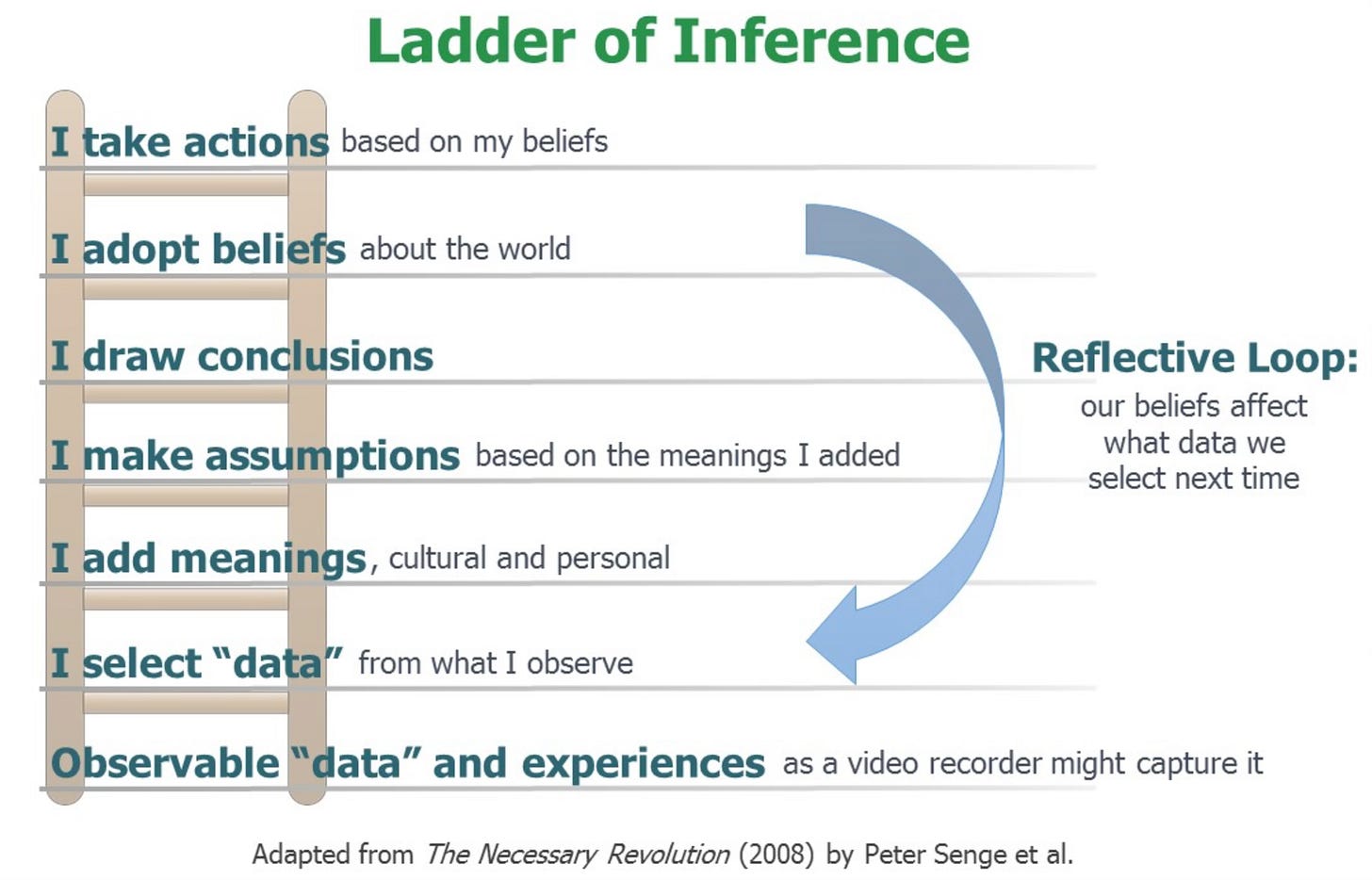The Ladder of Inference
and that guy in line ahead of me
All I wanted was a medium cup of black coffee. I’m standing in line at the Starbucks downtown, and there is this one guy in front of me, taking his dear sweet time ordering like five drinks. I’m trying to figure him out. He’s got a New York accent, dressed trendy-casual, taking charge of the coffee needs of his small entourage with the same energy one might bring to the floor of the stock exchange. His voice is too loud for the setting.
“I’m gonna need that double-shot grande with soy milk and no foam; that’s no foam!” Every utterance to the barista, along these lines.
Meanwhile, my mental evaluation of this fellow clicks into place: self-absorbed, takes up as much space as he can, accustomed to being in control, likes having attention, abundant self-esteem, and no social awareness, whatsoever.
Let me pause here. My mental activity in that Starbucks is called “running up the ladder of inference,” referring to a diagram showing the steps we take (from the bottom of the ladder) to make inferences — general conclusions from specific experiences.
I’m focused here on how the mind takes a slice of reality, makes assumptions, and can reach very firm conclusions. Sometimes with alarming speed and confidence. (In his book Thinking Fast and Slow, Daniel Kahneman refers to this instinctive, emotional process as System 1. System 2 is more deliberative, logical and much slower.)
Here’s another example. Decades ago, a former partner and I were arguing over something I had said a week before. It got to the point where we were debating back and forth what words I had actually spoken. I didn’t remember my exact words from the previous week, but I knew what I thought I had said. Not at all curious about what I had meant to say, she delivered a line I do remember, forty years later:
“I know what I heard. I have ears!” (italics mine)
The line was delivered with such prosecutorial force that my case folded in front of me. I had no comeback.
We would split up within the year, not because of this particular exchange, but because, I think, of two divergent patterns of thought she and I represented.
For some people, there is no ladder of inference, no series of steps to reach a conclusion.
There is only reality, and what that reality means.
It is easy to imagine the comfort afforded someone who is super clear about the one right path, the one valid view, the indomitable truth of the matter. And there is value in this righteous view — especially when one is right.
For me, however, those intermediate steps between reality and conclusions — selecting certain data, making and testing assumptions — are essential to… well, everything. They acknowledge the fallibility of perception and invite questions about the process by which I make meaning, and how others do it. It opens up even the most entrenched conclusions to the possibility of revision and update.
Back at the Starbucks, my nemesis finally completes his order and steps to the back with his supplicants. I order my no-nonsense coffee, and present cash to the barista who informs me: “Your drink has been paid for by the gentleman,” and gestures behind me.
Stunned, I thank my nemesis-turned-angel, who offered simply:
“I took SO long. I’m sorry. It was the least I could do for you.”




Stewart! You probably knew I would eat this up, so let me confirm that you were RIGHT! Stories like these - beautifully told - give us exactly the information we need to prompt us to think more carefully, more critically about how we interact in the world. Ladders of Inference indeed!
Thank you for being a coffee drinker, one who didn’t let himself say the quiet part out loud, one who has a firm grasp on humility.